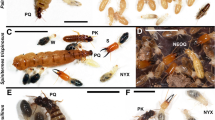Summary
The direct development ofNeotermes papua (Isoptera: Kalotermitidae) comprises four larval and three nymphal instars before the alate. The first five instars can be easily characterized. The second stage nymphs come morphologically close to the pseudergates, characterized by reduced wing buds. These nymphs can moult stationarily, i.e. with little morphological change, or to presoldiers, or proceed to the alate via the third nymphal stage. Pseudergates originate through a late and reversible deviation from the straight development to the alate. Presoldiers may derive from several stages, up to the last nymphal one; their production is subject to an inhibition by extant soldiers. This developmental schema is congruent with those described in other Kalotermitidae and the Termopsidae. By pinpointing the existence of a large pool of pluripotent individuals, in which the penultimate nymphal stage mingles with pseudergates, the present study also reveals a great similarity betweenNeotermes andProrhinotermes, and suggests that this developmental schema might be generally applicable to termites devoid of a permanent worker caste.
Similar content being viewed by others
References
Buchli, H. R., 1950. Recherches sur la fondation et le développement de nouvelles colonies chez le termite lucifuge (Reticulitermes lucifugus Rossi).Physiol. Comp. Ecol. 2:145–160.
Grassé, P.-P and C. Noirot, 1946a. La production des sexués néoténiques chez le termite à cou jaune (Calotermes flavicollis F.): inhibition germinale et inhibition somatique.C. r. Acad. Sci. 223:869–871.
Grassé, P.-P. and C. Noirot, 1946b. Le polymorphisme social du termite à cou jaune (Calotermes flavicollis F.). La production des soldats.C. r. Acad. Sci. 223:929–931.
Grassé, P.-P. and C. Noirot, 1947. Le polymorphisme social du termite à cou jaune (Calotermes flavicollis F.). Les faux-ouvriers ou pseudergates et les mues régressives.C. r. Acad. Sci. 224:219–221.
Heath, H., 1927. Caste formation in the termite genusTermopsis.J. Morphol. Physiol 43:387–425.
Karlshoven, L. G. E., 1930. De biologie van de djatitermiet (Kalotermes tectonae Damm.) in verband met zijn bestrijding.Meded. Inst. Plantenz. 76:1–154.
Lüscher, M., 1952. Untersuchungen über das individuelle Wachstum bei der TermiteKalotermes flavicollis F. (Ein Beitrag zum Kastenbildungsproblem).Biol. Zentralbl. 71:529–543.
Miller, E. M., 1942. The problem of castes and caste differentiation inProrhinotermes simplex (Hagen). Bull. Univ. Miami15:1–27.
Myles, T. G. and F. Chang, 1984. The caste system and caste mechanisms ofNeotermes connexus (Isoptera: Kalotermitidae).Sociobiology 9:163–319.
Nagin, R., 1972. Caste determination inNeotermes jouteli (Banks).Ins. Soc. 19:39–61.
Noirot, C., 1955. Recherches sur le polymorphisme des termites supérieurs (Termitidae).Annls. Sci. Nat. (Zool) 17:399–595.
Noirot, C., 1985a. Pathways of caste development in the lower termites. In:Caste Differentiation in Social Insects. Watson J. A. L., Okot-Kotber B. M. and Noirot C., Eds. Pergamon Press, Oxford, pp. 41–57.
Noirot, C., 1985b. The caste system in higher termites. In:Caste Differentiation in Social Insects. Watson J. A. L., Okot-Kotber B. M. and Noirot C., Eds. Pergamon Press, Oxford, pp. 75–86.
Noirot, C. and J. M. Pasteels, 1987. Ontogenetic development and evolution of the worker caste in termites.Experientia 43:851–860.
Noirot, C. and J. M. Pasteels, 1988. The worker caste is polyphyletic in termites.Sociobiology 14:15–20.
Pickens, A. L., 1934. The biology and economic significance of the western subterranean termite,Reticulitermes hesperus. In:Termites and Termite Control, 2nd edition. Kofoid C. A. (Ed.) University of California Press, Berkeley, pp. 157–183.
Renoux, J., 1976. Le polymorphisme deSchedorhinotermes lamanianus (Sjöstedt) (Isoptera — Rhinotermitidae). Essai d'interprétation.Ins. Soc. 23:279–494.
Roisin. Y., 1988. Morphology, development and evolutionary significance of the working stages in the caste system ofProrhinotermes (Insecta, Isoptera).Zoomorphology 707:339–347.
Roisin, Y., 1990a. Reversibility of regressive molts in the termiteNeotermes papua.Naturwissenschaften 77:246–247.
Roisin, Y., 1990b. Termite workers: a model for the study of social evolution. In:Social Insects and the Environment. Veeresh G. K., Mallik B. and Viraktamath C. A. (Eds.). Oxford & IBH Publishing Co., New Delhi, pp. 335–336.
Roisin, Y. and J. M. Pasteels, 1986. Differentiation of worker-derived intercastes and precoccious imagoes after queen removal in the Neo-Guinean termiteNasutitermes princeps (Desneux).J. Morphol. 189:281–293.
Roisin, Y. and J. M. Pasteels, 1991. Sex ratio and asymmetry between sexes in the production of replacement reproductives by the termite,Neotermes papua (Desneux).Ethol. Ecol. Evol., in press.
Sewell, J. J. and J. A. L. Watson, 1981. Developmental pathways in Australian species ofKalotermes Hagen (Isoptera).Sociobiology 6:243–324.
Springhetti, A., 1969a. Influenza dei reali sulla differenziazione dei soldati diKalotermes flavicollis (Isoptera).Prog. VI Congr. IUSSI, Bern 1969:267–273.
Springhetti, A., 1969b. Il controllo sociale della differenziazione degli alati inKalotermes flavicollis Fabr. (Isoptera).Ann. Univ. Ferrara (N.S.) Sez. III (Biol. anim.) 3:73–96.
Watson, J. A. L. and Sewell J. J., 1981. The origin and evolution of caste systems in termites.Sociobiology 6:101–108.
Watson, J. A. L. and J. J. Sewell, 1985. Caste development inMastotermes and Kalotermes: which is primitive? In:Caste Differentiation in Social Insects. Watson J. A. L., Okot-Kotber B. M. and Noirot C., Eds. Pergamon Press, Oxford, pp. 27–40.
Watson, J. A. L., E. C. Metcalf and J. J. Sewell, 1977. A re-examination of the development of castes inMastotermes darwiniensis Froggatt (Isoptera).Aust. J. Zool. 25:25–42.
Zimmermann, R. B., 1983. Sibling manipulation and indirect fitness in termites.Behav. Ecol. Sociobiol. 12:143–145.
Author information
Authors and Affiliations
Additional information
King Léopold III Biological Station, Laing Island, Papua New Guinea, contribution No. 235
Rights and permissions
About this article
Cite this article
Roisin, Y., Pasteels, J.M. Polymorphism in the giant cocoa termite,Neotermes papua (Desneux). Ins. Soc 38, 263–272 (1991). https://doi.org/10.1007/BF01314912
Received:
Revised:
Accepted:
Issue Date:
DOI: https://doi.org/10.1007/BF01314912




